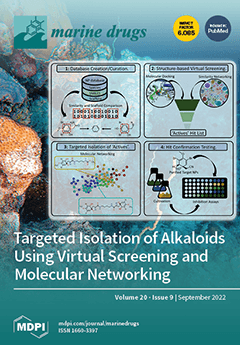Moromycin B (Mor B), saquayamycin B
1 (Saq B
1), saquayamycin B (Saq B), and landomycin N (Lan N), four angucyclines produced by the marine-derived actinomycete
Streptomyces sp., are a class of polyketone compounds containing benzanthracene. Here, the structure–activity relationship of these
[...] Read more.
Moromycin B (Mor B), saquayamycin B
1 (Saq B
1), saquayamycin B (Saq B), and landomycin N (Lan N), four angucyclines produced by the marine-derived actinomycete
Streptomyces sp., are a class of polyketone compounds containing benzanthracene. Here, the structure–activity relationship of these four compounds was analyzed in human colorectal cancer (CRC) cells. Saq B
1, which showed the strongest cytotoxicity with an IC
50 of 0.18–0.84 µM for CRC cells in MTT assays, was employed to test underlying mechanisms of action in SW480 and SW620 cells (two invasive CRC cell lines). Our results showed that Saq B
1 inhibited CRC cell proliferation in a dose- and time-dependent manner. Notably, lower cytotoxicity was measured in normal human hepatocyte cells (QSG-7701). Furthermore, we observed proapoptosis, antimigration, and anti-invasion activities of Saq B
1 in CRC cells. At the same time, the protein and mRNA expression of important markers related to the epithelial–mesenchymal transition (EMT) and apoptosis changed, including N-cadherin, E-cadherin, and Bcl-2, in Saq B
1-treated CRC cells. Surprisingly, the PI3K/AKT signaling pathway was shown to be involved in Saq B
1-induced apoptosis, and in inhibiting invasion and migration. Computer docking models also suggested that Saq B
1 might bind to PI3Kα. Collectively, these results indicate that Saq B
1 effectively inhibited growth and decreased the motor ability of CRC cells by regulating the PI3K/AKT signaling pathway, which provides more possibilities for the development of drugs in the treatment of CRC.
Full article






